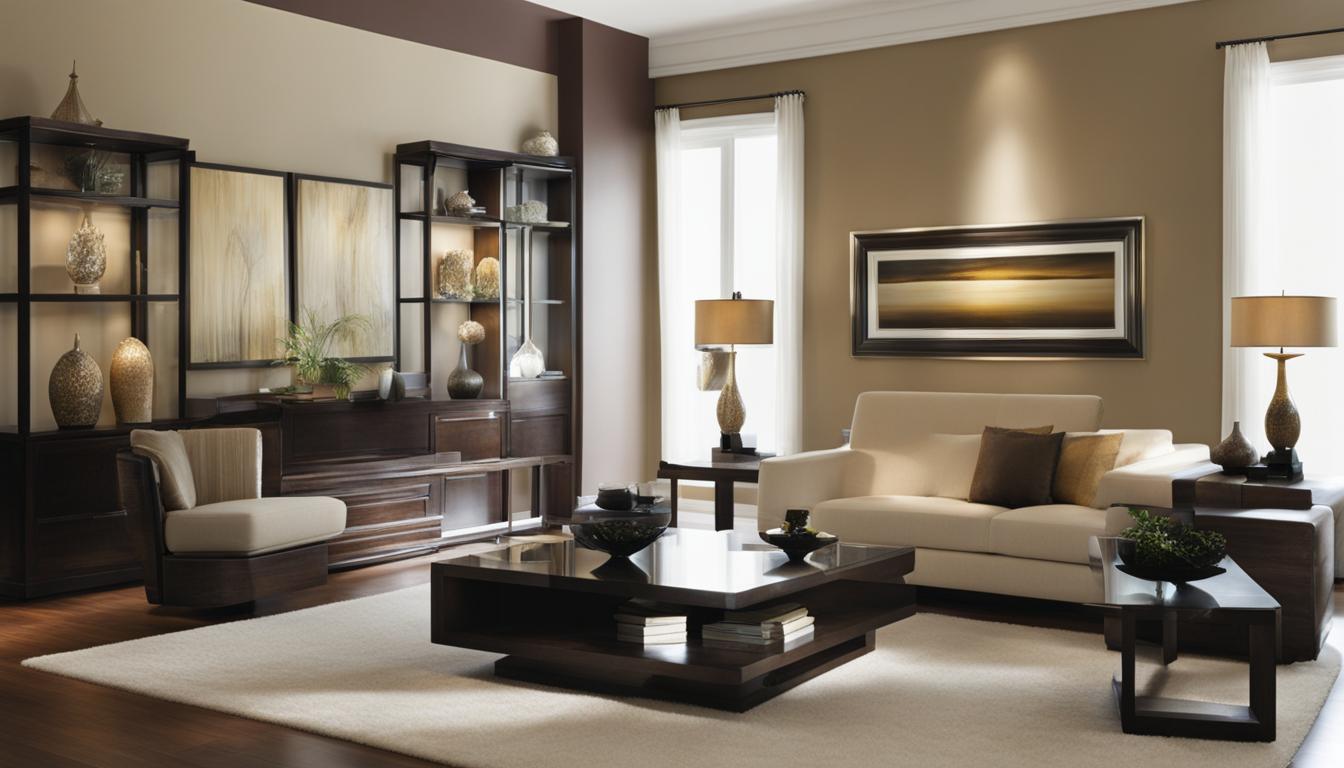Originally posted on October 28, 2023 @ 10:18 pm
Welcome to the fascinating world of Feng Shui, where the energy you surround yourself with can impact every aspect of your life. Good Feng Shui can bring prosperity, health, and happiness, while bad Feng Shui can cause stress, illness, and financial difficulties. In this section, we will explore the critical differences between good and bad Feng Shui and provide practical tips to create a harmonious and balanced living environment.
Whether you’re a Feng Shui enthusiast or new to this ancient practice, understanding the basics can help you transform your home into a sanctuary that supports your well-being and success. From assessing your home’s Feng Shui to utilizing symbols and objects, we will cover everything you need to know to create a positive energy flow in your space.
Key Takeaways:
- Good Feng Shui can bring prosperity, health, and happiness, while bad Feng Shui can cause stress, illness, and financial difficulties.
- Understanding the principles of Feng Shui is essential for identifying and rectifying bad Feng Shui in your home.
- Assessing your home’s Feng Shui and identifying any areas that may have negative energy is the first step in improving the overall Feng Shui.
- Specific Feng Shui practices can attract wealth and abundance into your life, create a harmonious atmosphere for love and romance, and support your health and overall well-being.
- Incorporating Feng Shui principles into your interior design choices can create a balanced and inviting space.
Exploring Feng Shui Principles
In Chinese culture, Feng Shui is the practice of arranging the environment in a way that promotes positive energy and balances the natural forces. The principles of Feng Shui have been used for over 3,000 years to create a peaceful, harmonious living space.
At its core, Feng Shui is based on the belief that everything in the universe is made up of energy, or chi. This energy can be manipulated and harnessed through the proper organization of the physical space around us. Understanding the basic principles of Feng Shui is crucial for creating a living environment that is both functional and harmonious.
The Five Elements
The Five Elements are a fundamental aspect of Feng Shui practice. These elements are Water, Wood, Fire, Earth, and Metal, and are believed to represent different aspects of the natural world. Each element is associated with specific colors, shapes, and materials that can be used to create a balanced and harmonious environment.
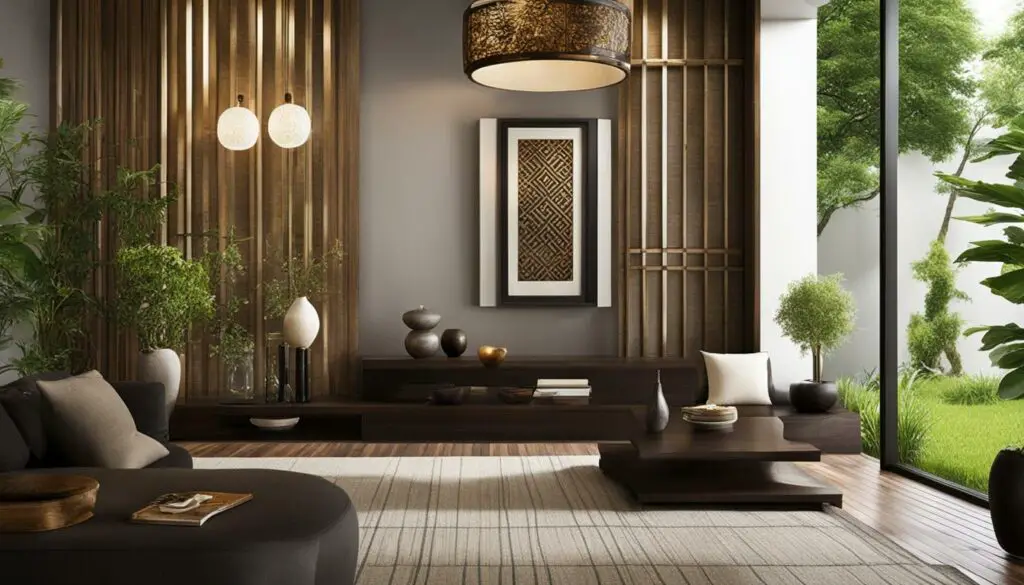
For example, the Water element is associated with the color blue, flowing shapes, and reflective materials, such as mirrors. To balance the Water element in a space, one might incorporate a fountain or aquarium.
The Bagua Map
The Bagua Map is a tool used in Feng Shui to identify the different areas of a space and their corresponding elements. The map is divided into nine sections, each representing a different aspect of life, such as career, relationships, and health. By identifying the Bagua areas of a space, one can apply the appropriate Feng Shui principles to enhance that area of life.
| Bagua Area | Associated Element | Color |
|---|---|---|
| Wealth | Metal | Gold, silver, white |
| Relationships | Earth | Pink, red, white |
| Fame and Reputation | Fire | Red, orange, purple |
| Health and Family | Wood | Green, brown |
| Center | Earth | Yellow |
| Children and Creativity | Metal | White, pastels |
| Knowledge and Self-Cultivation | Earth | Blue, green |
| Career | Water | Black, dark blue |
| Helpful People and Travel | Metal | Silver, white |
By using the Bagua map, one can create a more balanced and harmonious living space that supports their goals and aspirations.
The Yin and Yang
The principles of Yin and Yang are also central to Feng Shui practice. Yin and Yang represent the complementary forces of the universe, such as light and dark, hot and cold, and male and female. In Feng Shui, a harmonious living space must balance these opposing forces, creating a sense of harmony and balance.
For example, a room that is too dark may have an excess of Yin energy and feel oppressive or stagnant. By incorporating brighter colors and natural light, one can balance the Yin and Yang energy and create a more harmonious space.
Understanding the principles of Feng Shui is essential for creating a living environment that promotes positive energy and balance. By using tools such as the Bagua map and incorporating the Five Elements, one can create a harmonious space that supports their goals and aspirations.
Assessing Your Home’s Feng Shui
Assessing the Feng Shui of your home is an important step towards creating a harmonious living space. By identifying areas with negative energy, you can take steps to improve the overall Feng Shui of your home. Here are some tips for assessing and improving your home’s Feng Shui:
| Feng Shui Assessment Checklist | Solutions |
|---|---|
| Cluttered and disorganized space | Declutter, organize, and clean regularly to promote positive energy flow. |
| Dark and poorly lit areas | Add lighting fixtures or open curtains and blinds to allow natural light in. |
| Unfavorable layout | Rearrange furniture to create a more balanced energy flow. |
| Blockages and obstacles | Remove any physical or visual obstructions to promote positive energy flow. |
| Broken or damaged objects | Repair or replace any broken or damaged objects, as they can bring negative energy to your space. |
By addressing these common issues, you can significantly improve the Feng Shui of your home. Additionally, incorporating natural elements such as plants and using calming colors can also promote positive energy flow and create a more harmonious living environment.
When assessing your home’s Feng Shui, it’s important to trust your intuition and pay attention to how you feel in each space. A home with good Feng Shui should feel welcoming, peaceful, and supportive of your well-being.
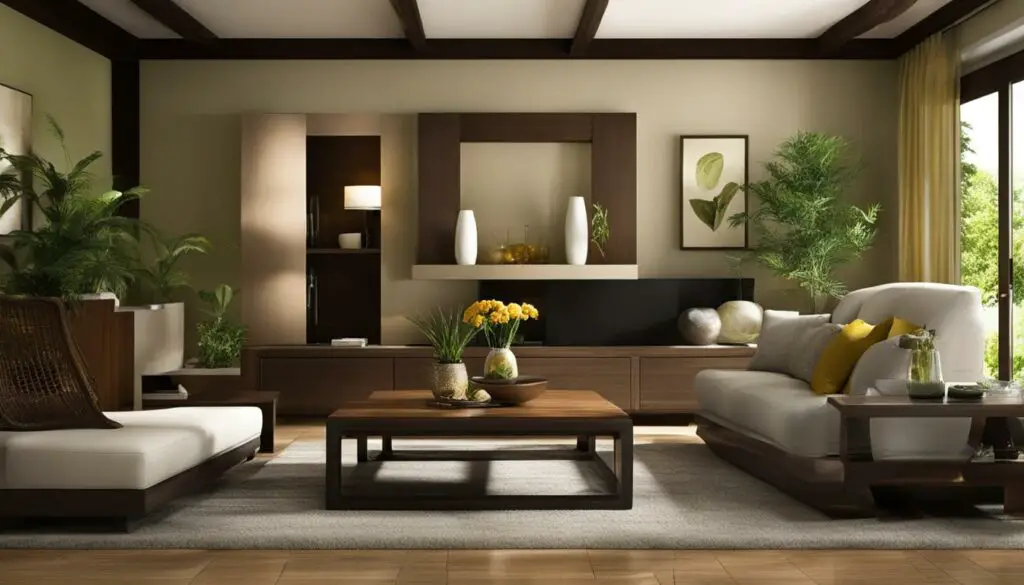
Enhancing Wealth with Feng Shui
If you’re looking to attract wealth and abundance into your life, incorporating Feng Shui principles into your home is a great place to start. Here are some tips to create a prosperous living environment:
- Declutter: One of the most basic principles of Feng Shui is to remove clutter from your home. A cluttered space can block the flow of positive energy and prevent abundance from coming into your life. Start by getting rid of items you no longer need, and organize the rest in a way that feels harmonious and balanced.
- Activate the Wealth Corner: In Feng Shui, the southeast corner of your home is known as the “wealth corner.” To activate this area, add elements that represent abundance, such as a vase of fresh flowers or a bowl of fruit. You can also place a wealth symbol, such as a money tree or a gold ingot, in this area.
- Use the Power of Color: Certain colors are believed to attract wealth and prosperity in Feng Shui. Shades of green, purple, and gold are especially powerful for enhancing abundance. You can incorporate these colors into your décor with throw pillows, rugs, or other accessories.
- Include Water: Water is a symbol of wealth and prosperity in Feng Shui. Adding a water feature, such as a fountain or fish tank, can attract positive energy and enhance your abundance.
- Arrange Furniture for Prosperity: The way you arrange your furniture can also impact your wealth in Feng Shui. Make sure your sofa or chairs face the entrance to your home to welcome abundance in. You can also place a mirror on a wall to reflect abundance back into your space.
- Use Crystals and Gemstones: Crystals and gemstones are believed to have powerful energy that can enhance abundance in a space. Citrine, pyrite, and amethyst are especially effective for attracting wealth and prosperity. You can place these stones on a windowsill or on a tabletop in the wealth corner of your home.

“Remember that creating wealth is not just about accumulating money or possessions; it’s also about cultivating a mindset of abundance and gratitude. Embrace the principles of Feng Shui to help you manifest prosperity in all areas of your life.”
Cultivating Love and Relationships with Feng Shui
Feng Shui can have a significant impact on your love life and relationships. By creating a harmonious and balanced living environment, you can promote positive energy flow and improve your romantic prospects. Here are some Feng Shui tips to help you cultivate love and relationships in your home.
Bedroom Placement
The placement of your bed is crucial in Feng Shui. Make sure it is positioned so that you can see the door but are not directly in line with it. A solid headboard is also recommended, as it symbolizes support in your relationship. Avoid placing your bed under a window, as this can create restless energy.
Color Palette
In Feng Shui, certain colors are associated with love and relationships. Use soft, romantic colors such as pink, red, and pastels in the bedroom to create a calm and welcoming atmosphere. Avoid using harsh or jarring colors that may create negative energy.
Symbolism
| Symbol | Meaning |
|---|---|
| Mandarin ducks | Represent a happy and faithful relationship |
| Double happiness symbol | Attracts happiness and love |
| Rose quartz | Promotes love and harmony |
Incorporating these symbols in your bedroom can enhance the positive energy and promote loving relationships.
Clutter
Clutter can create stagnant energy, which can negatively impact your relationships. Keep your bedroom clean and clutter-free, and avoid storing items under your bed.
By implementing these simple Feng Shui remedies, you can create a harmonious and loving environment in your home.

Promoting Health and Well-being with Feng Shui
Feng Shui is not just about creating a visually appealing living space, but it’s also about promoting good health and well-being. By harnessing positive energy flow, Feng Shui can help create a healthy and balanced home environment.
One of the essential principles of Feng Shui is the balance of the five elements – wood, fire, earth, metal, and water. When designing your home, it’s important to incorporate all five elements to promote good health and well-being.
Here are some practical Feng Shui remedies for promoting health and well-being:
1. Incorporate Natural Elements
When it comes to promoting health and well-being, nature is your best friend. By incorporating natural elements into your living space, such as plants, flowers, and crystals, you can create a sense of calm and balance. Plants are particularly beneficial for purifying the air and improving mental clarity.

2. Balance Energy Flow
Energy flow is a crucial aspect of Feng Shui. When the energy in your home is stagnant or blocked, it can cause health and emotional issues. To promote good health, ensure there’s adequate airflow and natural light in your home. Open windows, use air-purifying plants, and avoid clutter to ensure positive energy flow.
3. Use Soothing Colors
The colors in your home can affect your emotions, energy levels, and overall well-being. To promote good health and relaxation, use soothing colors like blue, green, and earth tones. Avoid loud, bright colors that can cause stress and anxiety.
4. Remove Electronics from the bedroom
The bedroom is one of the most critical areas of your home for promoting health and well-being. To create a restful and healthy space, remove electronics like TVs and computers from your bedroom. These devices emit harmful electromagnetic fields that can interfere with your sleep and overall health.
5. Create a Space for Meditation and Reflection
Meditation and reflection are essential for good mental and emotional health. Create a space in your home where you can meditate, reflect, and connect with your inner self. Use peaceful décor, such as candles, soft pillows, and natural elements.
By incorporating these Feng Shui remedies into your home, you can promote good health and well-being in your living environment. Remember, a healthy home is a happy home!
Identifying Bad Feng Shui
Bad Feng Shui can have a significant impact on your life, leading to stress, health problems, and financial difficulties. In this section, we will discuss the signs of bad Feng Shui in your home and how to address them.
Clutter and Blocked Energy Flow
One of the most common signs of bad Feng Shui is clutter. When you have too much stuff in your home, it can block the flow of energy and create a feeling of chaos. To remedy this, declutter your home by getting rid of anything you no longer need or use. Donate or sell items that are in good condition, and throw away anything that is broken or no longer serves a purpose.

Unfavorable Layouts and Furniture Placement
The way your furniture is arranged can also impact the flow of energy in your home. A layout that forces you to walk around obstacles or navigate through cramped spaces can create a feeling of unease. To improve the layout of your home, consider rearranging your furniture to create a more open and welcoming space.
Negative Colors and Symbols
The colors and symbols in your home can also contribute to bad Feng Shui. For example, dark colors like black and red can create a feeling of heaviness, while symbols of violence or aggression can create a sense of fear or anxiety. Replace negative colors with soothing pastels or earth tones, and replace violent symbols with peaceful ones.
Broken or Damaged Items
Another sign of bad Feng Shui is broken or damaged items in your home. These items can create negative energy and interfere with the flow of positive energy. Replace broken items with new ones, and repair any damaged items that can be salvaged.
Conclusion
By identifying the signs of bad Feng Shui in your home, you can take steps to address them and create a more harmonious living environment. Whether it’s decluttering your space, rearranging your furniture, or replacing negative colors and symbols, there are plenty of solutions to enhance your home’s positive energy flow and improve your overall well-being.
The Impact of Colors in Feng Shui
Colors play a significant role in Feng Shui, as they can affect the energy flow and overall ambiance of a space. Each color is associated with a specific element and has its unique meaning, making it essential to choose the right colors for different areas in your home.
Here are some tips for using colors in Feng Shui:
- Red: Red is a powerful color that represents passion, love, and warmth. It is a great option for the bedroom, but should be used sparingly in other areas of the home as it can be too stimulating.
- Yellow: Yellow is a cheerful color that represents happiness, positivity, and creativity. It is an ideal choice for the kitchen and dining room, as it stimulates digestion and conversation.
- Green: Green is a calming color that represents growth, harmony, and balance. It is perfect for the living room and study area, as it promotes relaxation and concentration.
- Blue: Blue is a soothing color that represents calmness, trust, and peace. It is suitable for the bedroom and bathroom, as it promotes restful sleep and relaxation.
- White: White is a pure color that represents clarity, cleanliness, and freshness. It is an excellent option for the bathroom and meditation room, as it supports inner reflection and purification.
The Psychology of Color
It’s important to note that the meaning of colors in Feng Shui can be influenced by personal experience and cultural background. The psychology of color plays a significant role in how colors are perceived, and it’s essential to choose colors that resonate with you and create a positive emotional response.
“Color is a power that directly influences the soul.” – Wassily Kandinsky
Experiment with different colors and observe how they make you feel. Pay attention to the colors that you’re drawn to and incorporate them into your home decor.

By incorporating color mindfully into your home decor, you can enhance the energy flow and create a harmonious and inviting living environment.
The Role of Furniture Placement in Feng Shui
One of the primary principles of Feng Shui is to ensure that energy flows freely throughout your home. Furniture placement plays a key role in achieving this balance and harmony. The arrangement of furniture can affect the energy flow in a room and impact the overall Feng Shui of your home.
To create good Feng Shui with furniture placement, consider the following tips:
- Organize your furniture in a way that allows for comfortable flow of movement throughout the room. Avoid creating obstacles that may impede energy flow, such as positioning furniture in cramped corners or blocking doorways with bulky pieces.
- Arrange your furniture with balance in mind. Balance the weight of larger furniture items by placing smaller objects on the opposite side of the room. Consider using symmetrical placement to create equilibrium in the space.
- Avoid placing furniture with sharp edges or corners facing directly at a seating area. These edges can create negative energy, known as “poison arrows,” that may lead to discomfort or conflict in the room.
- Position your bed, desk, and stove in a commanding position that allows for a clear view of the room’s entrance. This placement will help you feel in control and calm and create a sense of security in the space.
By following these furniture placement tips, you can create a harmonious and balanced living environment that promotes positive energy flow and good Feng Shui. Remember to always trust your instincts and arrange your furniture in a way that feels right for you and your home.
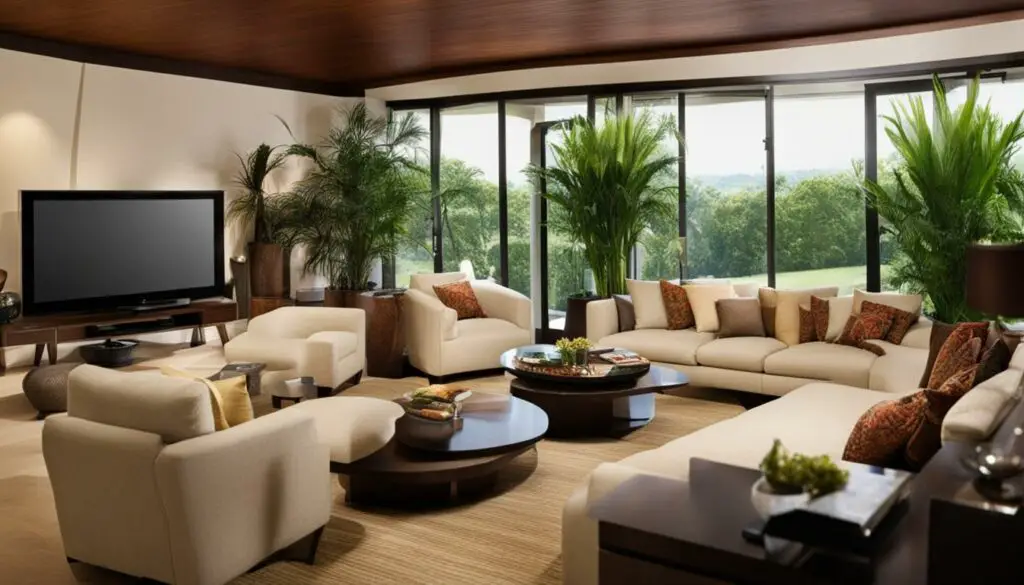
Utilizing Feng Shui Symbols and Objects
Feng Shui symbols and objects have long been used to attract positive energy and bring harmony to living spaces. By incorporating these powerful tools into your home, you can create a sanctuary of peace and balance. Let’s explore some common Feng Shui symbols and how to use them effectively.
The Bagua Map
The Bagua Map is one of the most essential tools in Feng Shui practice. This eight-sided map is used to identify energy centers and determine where to place specific symbols and objects in your home. Each section of the map represents a different aspect of life, such as wealth, relationships, and creativity.
To use the Bagua Map, simply overlay it onto a floor plan of your home, aligning the bottom of the map with your front door. This will help you identify which areas of your home correspond to each aspect of the map. For example, the wealth section is typically located in the southeast corner of your home.
Lucky Bamboo
Lucky Bamboo is a popular Feng Shui symbol that is believed to bring good luck and prosperity. This fast-growing plant is easy to care for and can be displayed in a variety of ways, such as in a glass vase or tied with red ribbon.
To use Lucky Bamboo in your home, place it in the wealth section of the Bagua Map or in the corner of your desk at work. You can also use it to balance the energy in a room by placing it in a corner that feels stagnant or heavy.
Crystals
Crystals are another powerful Feng Shui symbol that can be used to cleanse and balance energy in your home. Clear quartz, for example, is believed to amplify energy and promote clarity and focus.
To use crystals in your home, consider placing them in areas that feel heavy or cluttered, such as a home office or kitchen. You can also wear crystals as jewelry to benefit from their energy throughout the day.
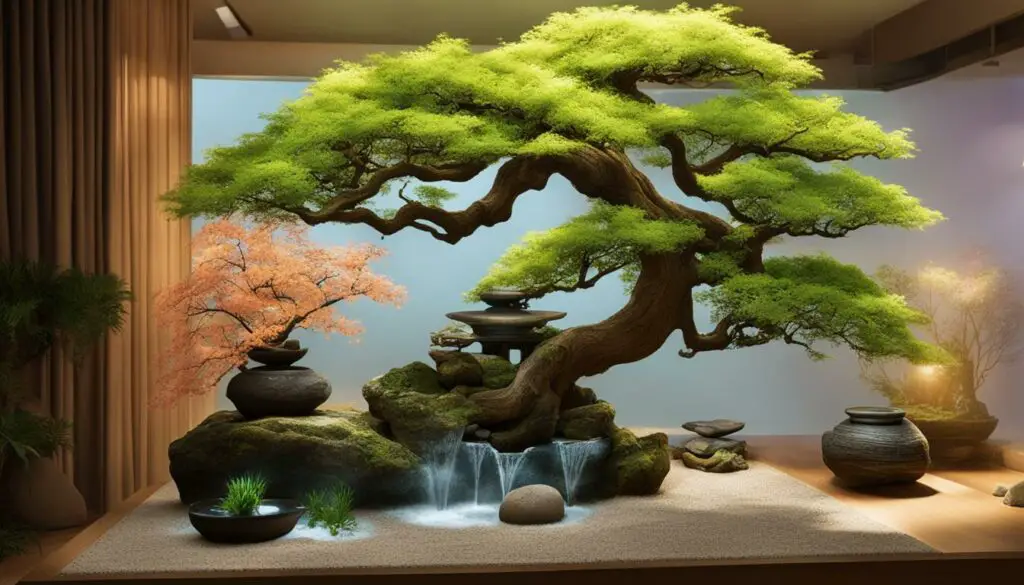
Good Luck Coins
Good Luck Coins are a popular Feng Shui symbol that is believed to attract wealth and abundance into your life. These coins typically have a square hole in the center and are tied together with red thread or ribbon.
To use Good Luck Coins in your home, place them in the wealth section of the Bagua Map or in the southeast corner of your desk at work. You can also carry them with you in your wallet or purse to attract financial prosperity.
The Laughing Buddha
The Laughing Buddha is a popular Feng Shui symbol that is believed to bring happiness, prosperity, and good luck. This jolly figure is typically depicted with a large belly and a happy expression.
To use the Laughing Buddha in your home, place it in the wealth section of the Bagua Map or in a prominent location in your living room. You can also give it as a gift to a friend or loved one to share its positive energy.
By incorporating these Feng Shui symbols and objects into your home, you can create a more balanced and harmonious living environment. Experiment with different symbols and see how they influence the energy of your space.
Feng Shui for Different Areas of Your Home
Applying Feng Shui principles to different areas of your home can have a significant impact on the energy flow and ambiance. Here are some tips to harness the power of Feng Shui in various spaces:
The Bedroom
The bedroom is a vital space for creating a restful and peaceful atmosphere. It is essential to arrange the bed in a commanding position, where you have a clear view of the door but are not directly in line with it. Use soothing colors like blues and greens and avoid harsh lighting.
The Living Room
The living room is a space for relaxation and entertainment, so it should have a warm and inviting vibe. Arrange furniture in a way that encourages conversation and promotes relaxation. Use elements like plants and artwork to uplift the energy and create a visually appealing space.
The Kitchen
The kitchen is a vital area for nourishment, and its Feng Shui can influence the health and wealth of the household. Keep the kitchen clean and organized, and use natural elements like wood and stone to balance the energy. Avoid clutter and broken appliances.
The Entrance
The entrance is the first impression of your home, and it should have a welcoming and inviting feel. Use bright lighting to promote positive energy and hang a mirror to expand the space and attract abundance. Keep the entrance clean and free of clutter.
Image related to Feng Shui for Different Areas of Your Home:

Implementing Feng Shui principles in different areas of your home can create a harmonious and balanced living environment. By following these tips, you can improve the energy flow and ambiance of your home.
Creating a Balanced and Harmonious Workspace
Applying Feng Shui principles to your office can help create a productive and harmonious work environment. Here are some Feng Shui tips for your workspace:
- Position your desk: Your desk should be placed in the commanding position, facing the door but not in line with it. This gives you a sense of control and allows you to see who is entering your space. If you can’t move your desk, use a mirror to reflect the door.
- De-clutter: Clutter can create stagnant energy and prevent productivity. Keep your desk clean and tidy, and only have items you use frequently on your desk.
- Incorporate plants: Adding a plant to your workspace can improve air quality and add a natural element. Choose a plant with rounded, soft leaves, and place it in the east or southeast corner of your desk.
- Use calming colors: Blue and green are great colors to promote calmness and focus. Use these colors in your office decor to create a serene environment.
- Avoid sharp edges: Furniture with sharp edges can create negative energy and cause discomfort. Choose furniture with rounded edges and avoid placing your desk or chair in a corner.
By incorporating these Feng Shui tips, you can create a workspace that promotes productivity, creativity, and overall well-being. Take a look at the image below for a visual representation of a Feng Shui office:

Incorporating Feng Shui in Interior Design
Feng Shui principles can be seamlessly integrated into your interior design choices to create a balanced and inviting space. By keeping a few essential tips in mind, you can transform any room into a sanctuary of positive energy.
Lighting
Lighting plays a significant role in Feng Shui. The ideal balance of natural and artificial light can create an atmosphere of warmth, tranquility, and harmony. When selecting lighting fixtures, consider their color, shape, and placement. Soft, warm light is best for creating a relaxing atmosphere, while bright light may be suitable for workspaces and areas where energy flow needs to be stimulated.
Mirrors
Mirrors are a powerful tool in Feng Shui, reflecting and amplifying the energy flow in a room. When placing mirrors, consider what they will be reflecting. Avoid positioning mirrors to reflect clutter or negative energy, as this can create a lot of confusion in the room. Instead, place mirrors in a way that reflects natural light or beautiful artwork or scenery.
Plants
Plants are a natural way to bring positive energy into a room. They help purify the air and create a calming atmosphere that promotes well-being. When incorporating plants into your interior design, choose ones that are well-suited to the room’s lighting and temperature. Additionally, consider the placement of the plants to ensure they do not block energy flow or create clutter.
Textiles and Colors
Textiles and colors can play a crucial role in enhancing the Feng Shui of a room. When selecting textiles such as curtains, rugs, and pillows, choose colors and patterns that promote positive energy and balance. Feng Shui colors include blue, green, purple, and pink, which are ideal for bedrooms and relaxation spaces. Yellow, red, and orange are good for promoting energy and creativity in areas like the living room or workspace.

Tip: To integrate Feng Shui principles into your existing decor, consider adding small decorative items like crystals or figurines that represent positive energy and balance. Additionally, you can rearrange furniture or add storage solutions to reduce clutter and improve energy flow.
By incorporating these Feng Shui tips into your interior design, you can create a harmonious and balanced living space that supports your well-being and promotes positive energy.
Conclusion
Good feng shui is a powerful tool for creating a harmonious and balanced living environment. By understanding the basics of feng shui principles and assessing the energy flow of your home, you can identify and rectify areas with bad feng shui.
Implementing feng shui solutions and remedies, such as incorporating auspicious symbols and utilizing proper furniture placement, can enhance your wealth, love life, and overall well-being.
Take advantage of the impact of colors and the power of feng shui symbols to create positive energy throughout your home. And don’t forget to apply feng shui principles to different areas of your home, from the bedroom to the workplace.
By integrating feng shui into your interior design choices, you can create a space that supports your success and well-being. Say goodbye to bad feng shui and welcome positive energy into your life with these tips and tricks!
FAQ
What is Feng Shui?
Feng Shui is an ancient Chinese practice that aims to harmonize the energy flow in a space to create a balanced and harmonious environment.
How can Feng Shui improve my home?
Feng Shui can improve your home by enhancing the energy flow, promoting harmony and balance, and creating a positive and supportive atmosphere.
Can Feng Shui attract wealth and abundance?
Yes, Feng Shui can attract wealth and abundance by using specific techniques such as placing wealth symbols, arranging furniture, and activating the wealth corners of your home.
How can I assess the Feng Shui of my home?
You can assess the Feng Shui of your home by looking for signs of blocked energy, clutter, unfavorable furniture placement, and imbalances in the different areas of your space.
What are some common signs of bad Feng Shui?
Common signs of bad Feng Shui include cluttered spaces, blocked energy flow, uncomfortable furniture arrangements, and a general feeling of unease or stagnation in the environment.
Can Feng Shui improve my relationships?
Yes, Feng Shui can improve relationships by creating a harmonious and balanced environment that supports open communication, intimacy, and love.
How can I incorporate Feng Shui into my office?
You can incorporate Feng Shui into your office by considering the placement of your desk, organizing your workspace, and using colors and elements that promote focus, productivity, and success.
What role do colors play in Feng Shui?
Colors play a significant role in Feng Shui as they carry specific energies that can impact the mood, energy, and overall atmosphere of a space. Choosing the right colors for each area of your home is important to create balance and harmony.
Are there specific symbols or objects I can use in Feng Shui?
Yes, there are many symbols and objects you can use in Feng Shui to enhance the energy of your space. Examples include lucky charms, statues, crystals, and plants.
How can I apply Feng Shui principles to my bedroom?
You can apply Feng Shui principles to your bedroom by arranging the furniture for optimal energy flow, using soothing colors, incorporating soft lighting, and keeping the space clean and clutter-free.
Can Feng Shui impact my health and well-being?
Yes, Feng Shui can impact your health and well-being by creating a supportive and nurturing environment that promotes relaxation, balance, and vitality.
Is professional help necessary to practice Feng Shui?
While professional help can provide deeper insights and customized recommendations, it is not necessary to practice Feng Shui. You can start incorporating basic principles and making changes on your own.
